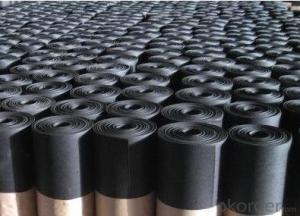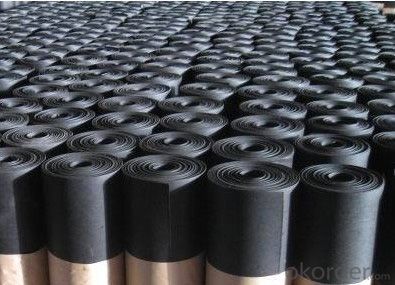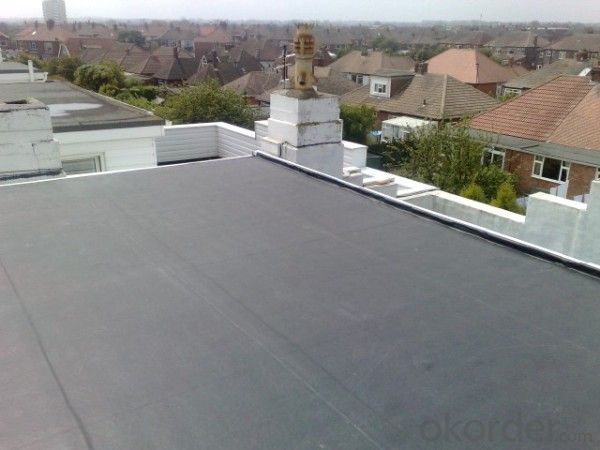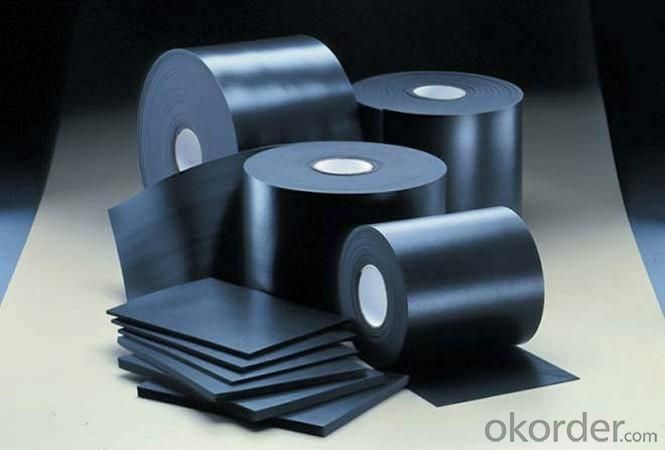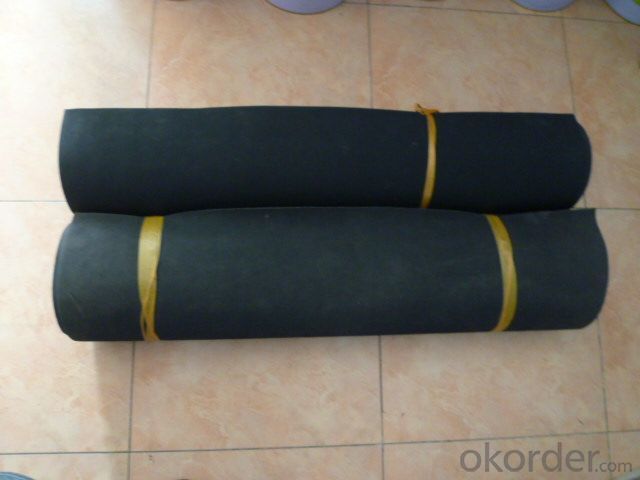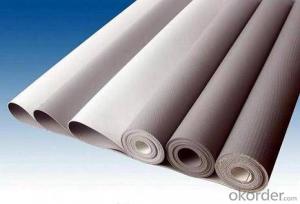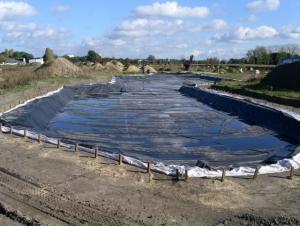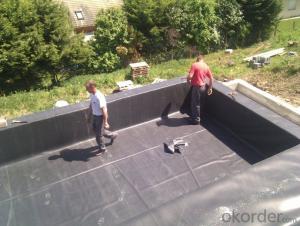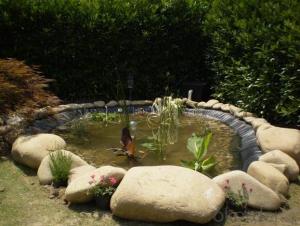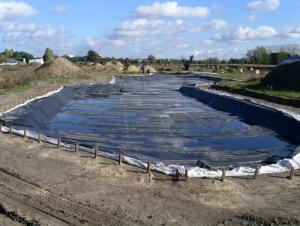EPDM Rubber Coiled Waterproof Membrane for Pond
- Loading Port:
- Shanghai
- Payment Terms:
- TT OR LC
- Min Order Qty:
- 50000 m²
- Supply Capability:
- 5000000 m²/month
OKorder Service Pledge
OKorder Financial Service
You Might Also Like
EPDM Rubber Coiled Waterproof Membrane for Pond
Description Of EPDM Rubber Coiled Waterproof Membrane for Pond:
•EPDM waterproof sheet has excellent anti-ozone-aging performance, able to resist ultraviolet light and corrosion of many chemical corrosive materials in the atmosphere
•It has high tensile strength, high ductility and strong retractility, it has excellent crack resistance, able to effect waterproof function even with tiny vibration of buildings.
• Excellent resistance to ozone, oxidation and sunlight.
• Resistance to chemicals; resistant to most inorganic products.
Main Features of EPDM Rubber Coiled Waterproof Membrane for Pond:
1>Excellent antiaging performance, service life up to 50 years
2>Working well with in 40C to 100C,it canbe constructed with a single layer in ambient temperature.
3>Waterproofing on various kinds of underground project,industrial of civil buildings and structures.
4>high extension rate, high tensile strength, small size changes at heat treatment
5>Good plant roots penetrability resistance and can be made waterproofing layer of planting roof
6>Special modified molecular structure ,effectively resolving the current domestic and foreign glue joint problem.
7>Good low temperature flexibility, and good performance of adapting to ambient temperature changes.
8>Convenient application ,solid joint, no environment pollution
9>chemical corrosion Resistance, can be used for special occasions
10>Convenient maitenance, low cost.
Specifications of EPDM Rubber Coiled Waterproof Membrane for Pond:
| Material | EPDM Rubber |
| Size | 1.2m (width)*20m (length) or customized, weldable type 2.05m or 4m width |
| Thick | 1.2mm, 1.5mm, 2.0mm |
| Type | Vulcanized & Weldable |
| Pattern | Non-reinforced (homogeneous) |
| Certificate | ISO9001/14001 |
Applications of EPDM Rubber Coiled Waterproof Membrane for Pond:
Widely used in roofs, basement, toilet ,swimming pool, and all kinds of industry and civil building waterproofing, reservoir, vivicism, bridge, underground, tunnel and dam waterproofing ,especially to the keystone waterproofing projects which is durability, high corrosion resistance and easy deformation.



IMages of EPDM Rubber Coiled Waterproof Membrane for Pond:




FAQ of EPDM Rubber Coiled Waterproof Membrane for Pond:
1. What are we supplying?
We are specialized in producing Colorful Asphalt Roof Shingle, SBS/APP modified bitumen waterproof membrane, Self adhesive bitumen waterproof membrane, PVC waterproofing membrane, EPDM rubber roofing membrane, Single Component Polyurethane Waterproof Coating, and Spray Polyurea Waterproof Coating
.
2. How Many years experience do we have?
We have been exported to more than 20 countries in the past 15 years.
3. How long do we usually reply your request?
We always reply our customer within 24 hours.
- Q: Can a waterproofing membrane be used on tunnels with communication systems?
- Yes, a waterproofing membrane can be used on tunnels with communication systems. In fact, it is highly recommended to protect sensitive communication equipment and wiring from water damage. A waterproofing membrane is designed to create a barrier against water infiltration, preventing leaks and seepage. By applying a waterproofing membrane to the tunnel walls and floors, the communication systems can be safeguarded from potential water-related issues, such as corrosion, short circuits, and signal disruption. It is important to choose a waterproofing system that is compatible with the specific needs and requirements of the communication systems in the tunnel to ensure optimal protection and functionality.
- Q: Can a waterproofing membrane be used on concrete bridges?
- Yes, a waterproofing membrane can be used on concrete bridges. Waterproofing membranes are commonly utilized in infrastructure projects, including concrete bridges, to protect the structure from water penetration and damage. These membranes create a barrier that prevents water from seeping into the concrete, thus enhancing the durability and longevity of the bridge.
- Q: How does a waterproofing membrane perform in areas with chemical exposure or solvents?
- A waterproofing membrane is designed to provide protection against water penetration, but it may not be effective against chemical exposure or solvents. Chemicals can potentially degrade or damage the membrane, compromising its waterproofing capabilities. It is important to select a membrane specifically designed for chemical resistance if the area is expected to have chemical exposure or solvents.
- Q: Can a waterproofing membrane be used in parking garages?
- Parking garages can benefit greatly from the use of a waterproofing membrane. Due to their exposure to various weather conditions and heavy vehicular traffic, these structures are susceptible to moisture infiltration and structural damage. Therefore, it is crucial to install a dependable waterproofing system to safeguard against water penetration and potential deterioration. A waterproofing membrane serves as an effective solution for parking garages by acting as a barrier against water and moisture. It is typically composed of durable materials such as modified bitumen, PVC, or EPDM, which are resistant to water intrusion. When applied to the concrete surface, the membrane forms a protective layer that prevents water from seeping through. By preventing moisture from penetrating the concrete, the waterproofing membrane not only defends the parking garage against water infiltration but also helps to prolong its lifespan. This, in turn, reduces the risk of corrosion, deterioration of reinforcing steel, and the formation of cracks. Ultimately, the structural integrity of the parking garage is maintained, saving on costly future repairs or replacements. Moreover, a waterproofing membrane can offer additional advantages, including resistance to chemicals, UV radiation, and abrasion. This makes it an ideal solution for parking garages that face harsh environmental conditions and heavy traffic. To summarize, the use of a waterproofing membrane is highly recommended for parking garages. It provides reliable protection against water infiltration, helps to maintain the structure's integrity, and extends its lifespan.
- Q: Can waterproofing membranes be used on underground tunnels?
- Yes, waterproofing membranes can be used on underground tunnels. Waterproofing membranes are specially designed to provide a barrier against water penetration and are commonly used in various construction applications, including underground structures such as tunnels. These membranes are typically made of materials like bitumen, asphalt, or synthetic rubber, which have excellent waterproofing properties. When applied to the tunnel walls and floors, waterproofing membranes create a protective layer that prevents water from seeping into the tunnel. This is particularly important in underground tunnels as they are susceptible to water intrusion from surrounding soil or groundwater. By using waterproofing membranes, the integrity and durability of the tunnel structure are maintained, reducing the risk of water damage, corrosion, and deterioration. Furthermore, waterproofing membranes can also offer additional benefits such as providing resistance against chemical attacks, preventing the growth of mold and mildew, and improving the overall insulation of the tunnel. These membranes can be applied during the construction phase of the tunnel or as a retrofit solution to existing tunnels. It is important to note that the selection of the appropriate waterproofing membrane should be based on factors such as the type of tunnel, the expected water pressure, and the overall design requirements. Consulting with a professional engineer or waterproofing specialist is highly recommended to ensure the selection and installation of the most suitable waterproofing membrane for underground tunnels.
- Q: Can a waterproofing membrane be used on swimming pools?
- Yes, a waterproofing membrane can be used on swimming pools. In fact, it is a common and effective method for ensuring the pool remains watertight. Waterproofing membranes are typically made of materials such as PVC or rubber and are specifically designed to prevent water from seeping through the walls or floor of the pool. These membranes are applied as a thin layer or sheet over the pool's surfaces, creating a barrier that keeps water contained within the pool. This helps to minimize the risk of leaks and water damage, ensuring the longevity and functionality of the swimming pool.
- Q: Are there any specific installation techniques for corners and edges when using a waterproofing membrane?
- Using a waterproofing membrane requires specific techniques for installing corners and edges. These techniques are necessary to guarantee proper sealing and protection against water infiltration. For corners, it is advisable to utilize corner flashings or preformed corner pieces that are specially designed for waterproofing applications. These flashings or pieces are typically made of flexible materials like rubber or PVC. They should be placed over the membrane, securely fastened to the substrate, and overlapped with the membrane to create a continuous barrier against water. When dealing with edges, installing edge flashings is crucial to prevent water from seeping beneath the membrane. Edge flashings are installed along the perimeter of the waterproofing membrane and are usually made of the same material as the membrane itself. They should be firmly sealed and securely fastened to the substrate to ensure a tight and dependable seal. In addition, it is important to properly overlap the membrane at corners and edges to create a seamless and continuous barrier against water. It is necessary to carefully follow the manufacturer's instructions to determine the correct width and method of overlap. In general, a minimum overlap of at least 2 inches is recommended for corners and edges. Overall, the specific installation techniques for corners and edges when using a waterproofing membrane involve the use of corner and edge flashings, proper sealing and fastening, and correct overlap of the membrane. By adhering to these techniques, a reliable and effective waterproofing system can be achieved.
- Q: Can a waterproofing membrane be used for a parking garage?
- Yes, a waterproofing membrane can be used for a parking garage. A waterproofing membrane is designed to provide a barrier against water infiltration, protecting the underlying structure from moisture damage. In a parking garage, where exposure to water and moisture is common due to rain, snow, and vehicle fluids, a waterproofing membrane can be a crucial component of the building envelope system. It can be applied to the concrete surfaces, including the floor and walls, to prevent water from seeping into the structure and causing deterioration, corrosion, or damage to the integrity of the parking garage. Additionally, a waterproofing membrane can also help to mitigate the risk of efflorescence, mold, and mildew growth, which can be common in damp environments. Therefore, using a waterproofing membrane in a parking garage is an effective way to ensure the long-term durability and functionality of the structure.
- Q: What is called a waterproof roll dry shop, wet shop
- Dry shop, wet shop is said self-adhesive coil. Dry shop is in the formation of the grass on the first layer of primary treatment agent, and then paving self-adhesive coil method is the easiest and fastest way.
- Q: How does a waterproofing membrane handle expansion and contraction of the substrate?
- A waterproofing membrane is designed to accommodate the expansion and contraction of the substrate through its flexibility and elasticity. It can stretch and contract along with the movement of the substrate, ensuring a watertight seal is maintained without compromising its integrity.
Send your message to us
EPDM Rubber Coiled Waterproof Membrane for Pond
- Loading Port:
- Shanghai
- Payment Terms:
- TT OR LC
- Min Order Qty:
- 50000 m²
- Supply Capability:
- 5000000 m²/month
OKorder Service Pledge
OKorder Financial Service
Similar products
Hot products
Hot Searches
Related keywords
